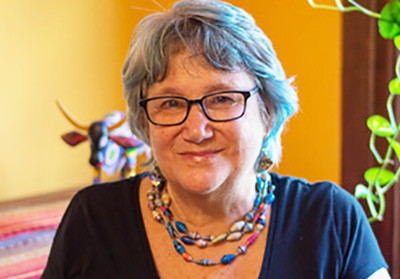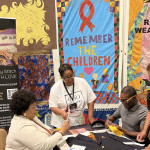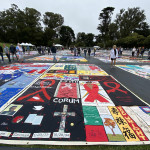As an idealistic young woman in her 20s, Elena Schwolsky, RN, MPH, traveled to Cuba in 1972, where she volunteered building houses with the Venceremos Brigade.

Courtesy of Elena Schwolsky
In May 2019, she visited the island again as part of a Rainbow World Fund delegation that also included AIDS Memorial Quilt cofounder Cleve Jones. The group brought sections of the American quilt to present at the Center for Sex Education in Havana, headed by Fidel Castro’s niece, Mariela Castro Espín. The trip included a visit to Los Cocos, Cuba’s largest HIV sanatorium, where members of Grupo de Prevención SIDA displayed sections of their own memorial quilt.
Schwolsky chronicles the years in between in her new memoir, Waking in Havana: A Memoir of AIDS and Healing in Cuba. The book describes her work as a nurse at a pediatric AIDS clinic in Newark; the death of her husband, Clarence, from AIDS (she remains HIV negative herself); and her time working at Los Cocos in the 1990s. Throughout the book, we meet some of the Cubans living with HIV who became part of her chosen family.

Waking in Havana by Elena Schwolsky
A Controversial Policy
Unlike in the United States, the first people affected by AIDS in Cuba were considered respected members of society. “The very first people infected on the island were returning military from Angola, diplomats and artists who had traveled abroad—these were not marginalized people at all,” Schwolsky says.
Starting in 1986, Cuba implemented its controversial policy of quarantining people with HIV in sanatoriums, starting with Los Cocos. Eventually there would be 14 such sites scattered across the island, three of which remain today.
When she visited Cuba as part of a Global Exchange public health delegation in 1991, Schwolsky had trouble accepting the policy of separating people with HIV from their loved ones, recalling how important the last years she shared with Clarence were to both of them. But over time, she came to understand the difficult balance between individual rights and the good of society.
“In the U.S., people described the sanatorium as a prison, but it was a comfortable residential community with a tremendous amount of support,” she says. It made sense on two levels: to prevent a widespread epidemic and to care for people who were already infected. I think in both those ways it was successful—Cuba has the lowest HIV prevalence rate in the Americas—but it was not without a personal toll for the people separated from their families and communities."
As an example, Schwolsky tells the story of Alejandro, a young gay man who was chosen to study nuclear chemistry in the Soviet Union, where he took advantage of the freedom of being away from parental authority. He tested positive for HIV when he donated blood for victims of Chernobyl. Government officials told him his father was gravely ill and put him on a flight back to Cuba. When the plane arrived, it was met by military jeeps and an ambulance. Alejandro was told he had AIDS and probably didn’t have long to live, and he was whisked off to the sanatorium.
During the “special period” of economic deprivation after the collapse of the Soviet Union, life in the sanatoriums was not without its benefits. Residents continued to receive their old salaries and had air conditioned housing and adequate nutrition, which was not always available outside. One man she met was an “auto-injector” who injected himself with HIV-infected blood so he could enter the sanatorium.
Policies began to change after early residents petitioned governmental officials—all the way up to Fidel Castro—saying they were not criminals and they had a right to live like human beings. People were allowed to visit their families, at first with an escort and later alone if they were deemed trustworthy. Some began working at outside jobs. Same-sex couples could live together, which was still socially frowned upon, and people could dress as they pleased.
“There were drag shows every Friday night, transvestites could dress as they wanted, gay couples could live together and were provided housing together in little apartments,” Schwolsky recalls. “They lived openly and without stigma. It was a place where people could really be themselves.”
Proyecto Memorias
In 1996, Schwolsky returned to Los Cocos as part of her master’s in public health fieldwork, helping Grupo de Prevención SIDA develop a training program for the country’s first AIDS peer educators. “They were already doing prevention education work at the sanatorium, but they hadn’t told their stories in communities on the outside,” she says. “They weren’t just going to be doing outreach as prevention educators, they were doing outreach as themselves—as people living with HIV.”
Schwolsky arrived not long after the quarantine policy was lifted and people with HIV could choose whether to live at a sanatorium or be treated as outpatients. About 80% of current residents decided to stay, but only around 20% of newly diagnosed people opted to enter. Today, the sanatoriums house a couple of hundred people who have complex medical needs or would have trouble living outside, as well as a few deemed to be at risk of transmitting the virus. Newly diagnosed people are encouraged to live at a sanatorium for a few months to learn how to manage their disease and prevent transmission.

Proyecto Memorias AIDS memorial quilt at Los CocosLiz Highleyman
As part of the training program, Schwolsky led a workshop called “Telling Your Story,” where she told her own story of making a quilt panel for Clarence. “I passed around pictures, and the whole workshop stopped,” she recalls. “People were blown away—it just resonated immediately, and they said, ’Let’s make a panel.’” After she left, the group kept going and created Proyecto Memorias. “They got panels from all over the island. The quilt was displayed in parks and at conferences and became a big centerpiece of their prevention work. It’s a testament to how a simple idea that grew into such an amazing emblem of struggle in the United States translated to their work there, even though there’s no Spanish word for quilt.”

Elena Schwolsky (front) and members of Los Cocos staff and Rainbow World Fund delegation look at Proyecto Memorias AIDS quiltLiz Highleyman
Among the members of Grupo de Prevención SIDA and Proyecto Memorias we meet in Waking in Havana, two have died and one still lives at Los Cocos, Schwolsky says. Alejandro was among those who left right away; he now lives with his male partner in the house in Havana where he was born.
Another man now lives in the United States. He had been very ill with drug-resistant virus and needed the best possible antiretroviral treatment. Under Cuba’s universal health system, all people living with HIV are eligible to receive free treatment, but access to the latest drugs is limited by the ongoing U.S. embargo.
Schwolsky’s experiences in Cuba over the years both helped her heal from her own grief and taught her some important life lessons.
“I learned how careful, humble and sensitive one needs to be when accessing another cultural experience. I had my own feelings and opinions, but I wanted to enter with an open mind and really try to understand what was unfolding in its own context,” she says. “I also learned how powerful shared emotional experiences can be in cutting through cultural and political boundaries. There is a shared experience of stigma, loss, strength, caregiving—all of those things are universal.”
Click here to read more about the history of the response to HIV/AIDS in Cuba.







1 Comment
1 Comment